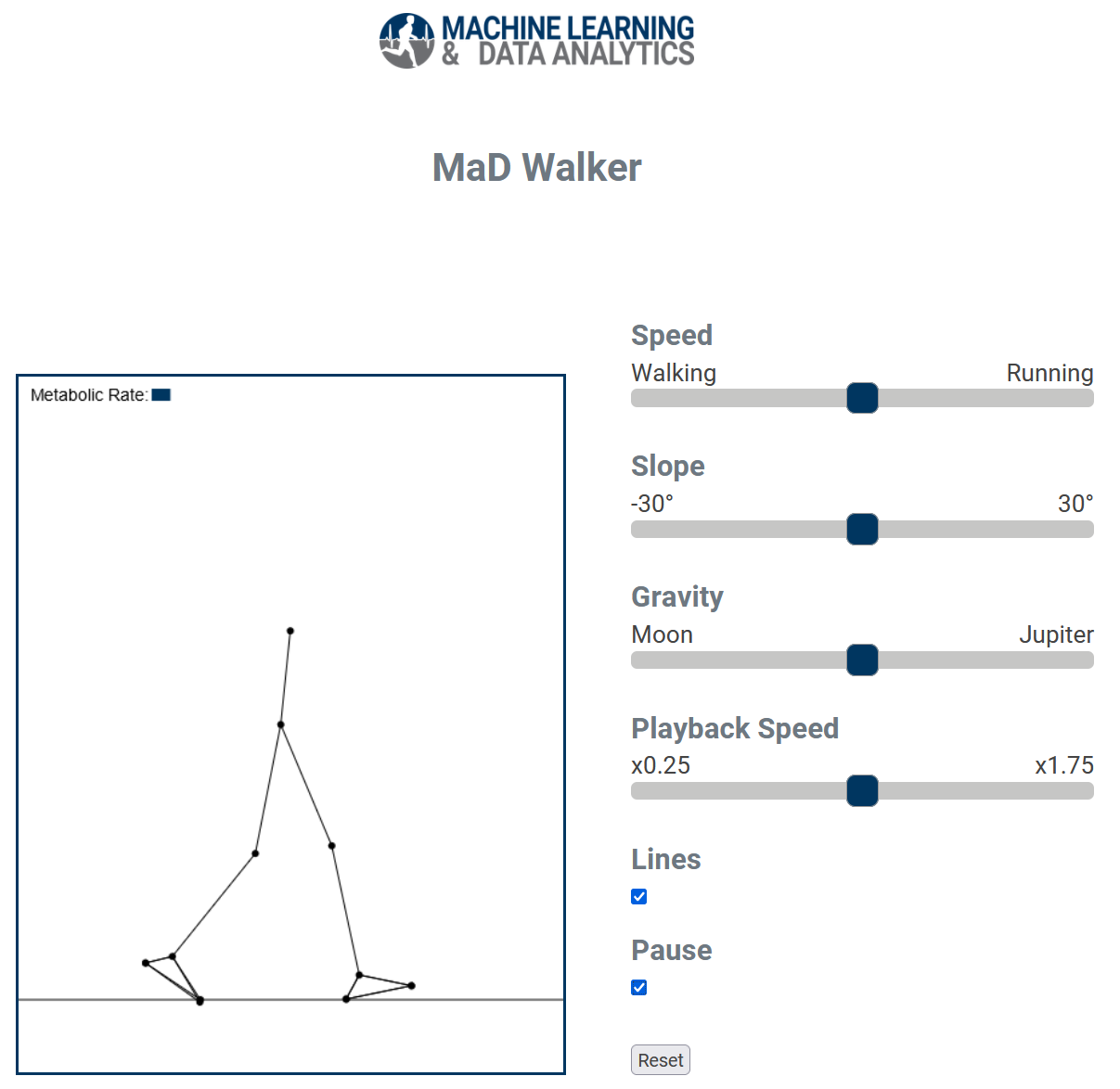Index
Biomechanical Motion Analysis and Creation
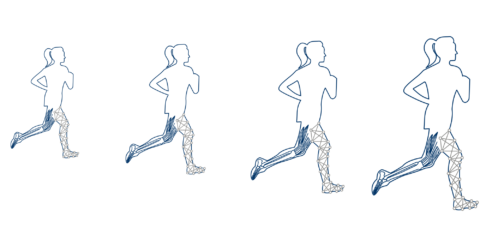
The Biomechanical motion analysis and creation (BioMAC) group aims to develop methods for accurate predictions and reconstructions of human motion, with a focus on gait. With our research, we aim to better understand human motion, and use this understanding to improve design of devices, such as prostheses, exoskeletons, and running shoes, as well as prevent injuries, such as knee osteoarthritis or ligament tears. To achieve our goals, we combine physics-models with machine learning methods to create accurate movement simulations. We use these to make predictions of new movements, e.g., when wearing a prosthesis or a specific running shoe, and to make reconstructions. Then, our aim is to create movement analyses from wearable sensor data that are as accurate as lab-based movement analysis methods. To create movement simulations, we replicate the optimization that the central nervous system performs when planning and executing movements digitally by solving optimal control problems. In an optimal control problem, we model the human body using a musculoskeletal model with multibody and muscle dynamics. We use an objective related to energy minimization and define the movement task using constraints.
Group Head
Group Members
Presentations and Videos
Presentations & Videos
Demo
This demo shows how the developed methods can be used to reconstruct measured movement but also to predict movements in response to environmental changes:
Projects
In collaboration with the Machine Learning and Data Analytics (MAD) Lab:
Machine Learning for Neuromusculoskeletal Modelling (C03)Past Projects
Research
The overarching research objective of the Chair of Autonomous Systems and Mechatronics is to develop technical systems that functionally support their users and provide them with a positive experience. To specifically promote user acceptance, human factors and technical requirements are equally considered. Our research approach is outlined in the figure and based on a mixture of methods from engineering and human sciences. We demonstrate our findings on wearable systems such as prostheses or exoskeletons, cognitive systems such as collaborative or humanoid robots, and general applications with tight human-robot interaction.
The key research questions of the Chair of Autonomous Systems and Mechatronics are:
- Which design, control, and interface implementations support human-machine interaction?
- How do human factors influence human-machine interaction and how can they be considered systematically in design?
Components and Control |
Interfaces and Interaction |
|
Wearable Systems |
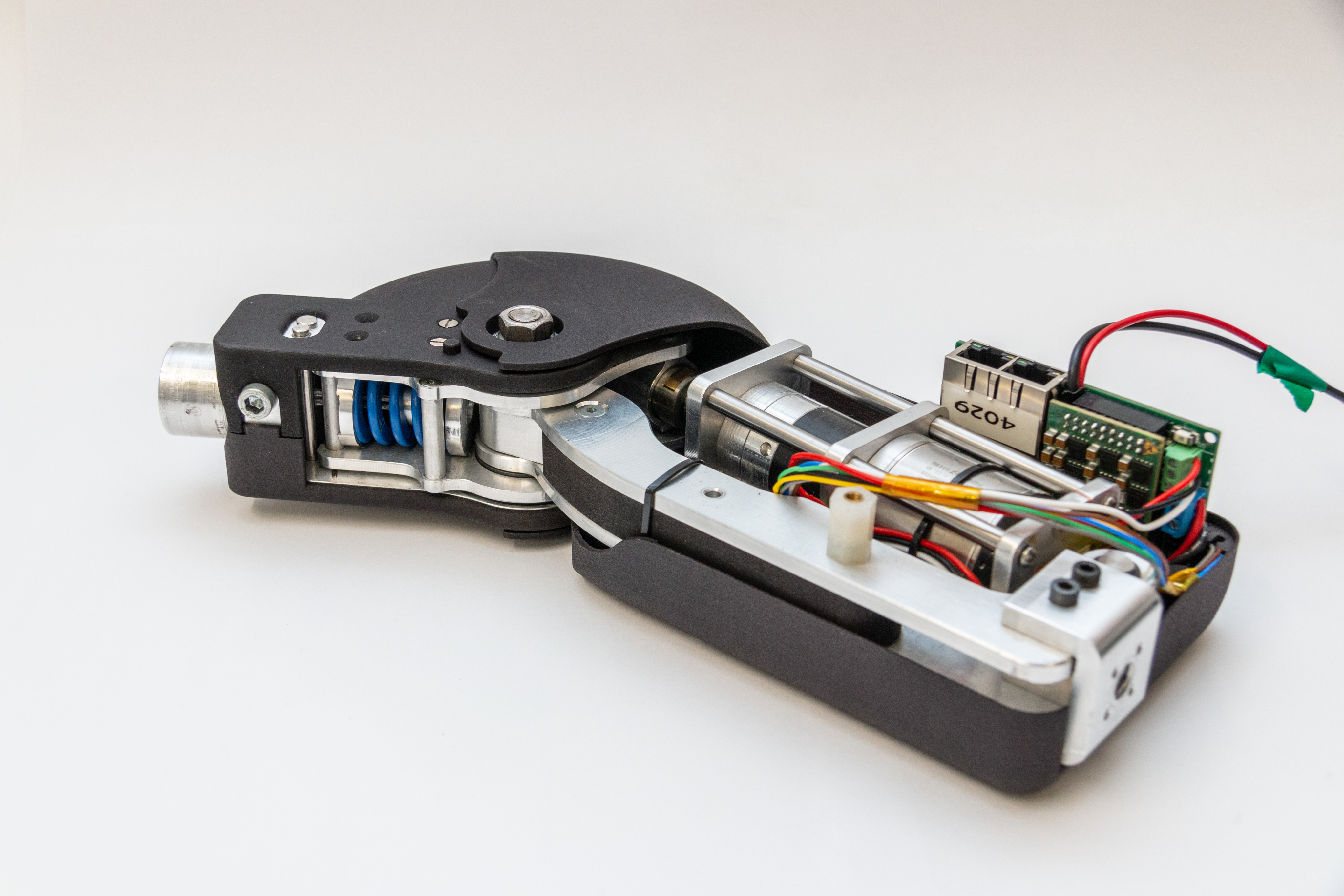 |
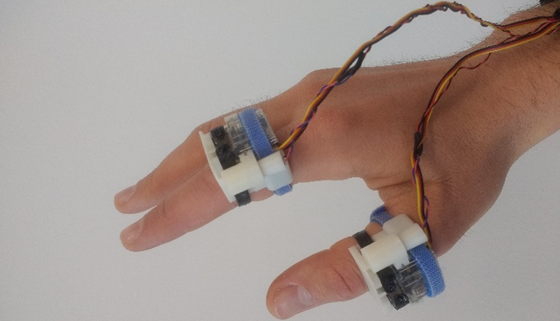 |
Cognitive Systems |
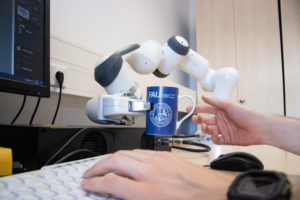 |
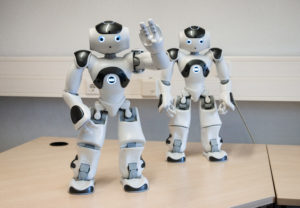 |
Interfaces and Interaction
For intuitive interaction, autonomous and mechatronic systems have to acquire and interpret multimodal sensor data and provide feedback, taking into account the physical abilities of the users. Especially in wearable robotic systems, user interface design is of utmost importance because the system should be perceived as a part of the user’s own body.
Therefore, our research focuses on improving our understanding of human perception and experience as well as the development of user-oriented interfaces for technical systems in general. To improve the integration of wearable robotic systems into their users’ body experience and the user experience of cognitive systems, we investigate the influence of different sensors, stimulators, and interaction strategies. To this end, we modify experimental approaches from psychological and cognitive science research into human-in-the-loop experiments to investigate underlying mechanisms and their practical consideration.
Current projects on this topic
Integrated models of cognitive and physical human-robot interaction
Funded by the Volkswagen Foundation: 9B 007
Combining the perspectives from engineering, biomechanics (Univ. Tübingen), and cognitive science (TU Berlin), we aim at developing unified models of physical and cognitive human-robot interaction. Working towards that goal, we prepare novel concepts for interdisciplinary discourse and teaching to motivate structural changes supporting inter-institutional collaboration. We expect the resulting interaction models will cover cognitive, musculo-skeletal, and control aspects, to improve joint cognitive decisions and physical robot assistance through user-centered human-robot interaction design.
- Hao, C., Russwinkel, N., Haeufle, D. F., & Beckerle, P. (2023). A Commentary on Towards autonomous artificial agents with an active self: Modeling sense of control in situated action. Cognitive Systems Research, 79, 1-3.
- Beckerle, P., Hao, C., Haeufle, D. F., & Russwinkel, N. (2022). Four considerations on interdisciplinary learning at the boundaries of human and engineering sciences. In Frontiers in Education (Vol. 7). Frontiers Media SA.
Active transfer learning with neural networks through human-robot interaction (TRAIN)
Funded by the DFG: BE 5729/16
In order to be able to use autonomous robots flexibly in interaction with humans in the future, procedures are needed that enable the learning of various motor and manipulation skills and that can also be applied not only by experts. We aim to improve the learning of robot skills with neural networks, taking into account human feedback as well as the experience and instructions of the users. To implement this systematically, we evaluate subjective feedback and physiological data from user studies and develop assessment criteria for the development of human-oriented methods of transfer learning and the shared autonomy of humans and robots.
More information can be found here.
- Cansev, M. E., Xue, H., Rottmann, N., Bliek, A., Miller, L. E., Rueckert, E., & Beckerle, P. (2021). Interactive Human–Robot Skill Transfer: A Review of Learning Methods and User Experience. Advanced Intelligent Systems, 3(7), 2000247.
- Denz, R., Demirci, R., Cansev, M. E., Bliek, A., Beckerle, P., Rueckert, E., & Rottmann, N. (2021, December). A high-accuracy, low-budget Sensor Glove for Trajectory Model Learning. In 2021 20th International Conference on Advanced Robotics (ICAR) (pp. 1109-1115). IEEE.
EFFENDI – EFficient and Fast text ENtry for persons with motor Disabilities of neuromuscular orIgin
Funded by the DFG: FE 936/6
People with motor impairments are often unable to operate a computer keyboard efficiently and therefore have to need alternative input methods. For users with neuromuscular diseases, this project will develop alternatives that can adapt to the individual symptoms of individual persons through modular, multi-sensory interfaces. The practical use of the resulting input devices is ensured as part of a human-centered development process through the continuous involvement of the target group.
- Gür, D., Schäfer, N., Kupnik, M., & Beckerle, P. (2020). A human–computer interface replacing mouse and keyboard for individuals with limited upper limb mobility. Multimodal Technologies and Interaction, 4(4), 84.
- Andreas, D., Six, H., Bliek, A., & Beckerle, P. (2022). Design and Implementation of a Personalizable Alternative Mouse and Keyboard Interface for Individuals with Limited Upper Limb Mobility. Multimodal Technologies and Interaction, 6(12), 104.
Completed Projects
Human-oriented methods for intuitive and fault-tolerant control of wearable robotic devices
Supported by the “Athene Young Investigator” program of TU Darmstadt
In this project, control approaches for wearable robotics systems for movement support and augmentation were developed to provide efficient and natural support and prevent users from feeling “controlled by the robot”. Psychophysical experiments of how users experience device elasticity help to tune adaptive impedance control to ensure versatile locomotion and fault tolerance. Human-in-the-loop experiments were applied to investigate the body scheme integration of wearable robotics systems by their users.
- Stuhlenmiller, F., Schuy, J., & Beckerle, P. (2018). Probabilistic elastic element design for robust natural dynamics of structure-controlled variable stiffness actuators. Journal of Mechanisms and Robotics, 10(1), 011009.
- Stuhlenmiller, F., Perner, G., Rinderknecht, S., & Beckerle, P. (2019). A stiffness-fault-tolerant control strategy for reliable physical human-robot interaction. In Human Friendly Robotics: 10th International Workshop (pp. 3-14). Springer International Publishing.
Users’ body experience and human-machine interfaces in (assistive) robotics
Funded by the DFG: BE 5729/3 & 11
The scientific network dealt with the body experience of individuals who use assistive or wearable robots. For a better understanding of technical possibilities to improve experiences, the participating scientists analyzed measures for the assessment of body representations and their consideration in novel design methods. This includes the identification of suitable perceptual channels and supports the development of new human-machine interfaces and human-in-the-loop experiments, i.e., robot hand/leg illusions.
Further information on the activities of the network can be found here.
- Beckerle, P., Kõiva, R., Kirchner, E. A., Bekrater-Bodmann, R., Dosen, S., Christ, O., … & Lenggenhager, B. (2018). Feel-good robotics: requirements on touch for embodiment in assistive robotics. Frontiers in neurorobotics, 12, 84.
- Beckerle, P., Castellini, C., & Lenggenhager, B. (2019). Robotic interfaces for cognitive psychology and embodiment research: a research roadmap. Wiley Interdisciplinary Reviews: Cognitive Science, 10(2), e1486.
Electromyographic (learning) control of robotic legs for the exploration of human body experience
Funded by the DFG: BE 5729/4
This cooperation with Arizona State University included the control of a robot leg to examine human body experience. A combination of electromyographic muscle activity measurement and machine learning was investigated for motion detection and control to improve the imitation of human motion and to extend evaluation methods for the experimental investigation of human body experience.
- Beckerle, P., Salvietti, G., Unal, R., Prattichizzo, D., Rossi, S., Castellini, C., … & Bianchi, M. (2017). A human–robot interaction perspective on assistive and rehabilitation robotics. Frontiers in neurorobotics, 11, 24.
Tactile interfaces to enhance human-machine interaction of wearable robotic systems by mediating affective and social touches
Funded by MERCUR: An-2019-0032
Tactile interfaces are essential for achieving a realistic human-robot interaction and the resulting body experience during wearable robot use. Sensory feedback to the users is very relevant here. In addition to purely functional information, feedback should include so-called affective signals, which mediate positive sensations when being touched slowly and are particularly relevant for social contacts. We analyze requirements for the transmission of such signals and develop demonstrators and algorithms for corresponding human-machine interfaces.
- Ege Cansev, M., Nordheimer, D., Andrea Kirchner, E., & Beckerle, P. (2021). Feel-good requirements: neurophysiological and psychological design criteria of affective touch for (assistive) robots. Frontiers in Neurorobotics, 90.
- Ferguson, N., Cansev, M. E., Dwivedi, A., & Beckerle, P. (2022, September). Design of a Wearable Haptic Device to Mediate Affective Touch with a Matrix of Linear Actuators. In Advances in System-Integrated Intelligence: Proceedings of the 6th International Conference on System-Integrated Intelligence (SysInt 2022), September 7-9, 2022, Genova, Italy (pp. 507-517). Cham: Springer International Publishing.
Human-Machine-Centered Design Methods
Human-machine-centered methods are crucial for the development of human-oriented technologies that synergistically interact with their users. Current research indicates that human factors and technical aspects should be equally considered to design efficient solutions that are accepted by users. For this purpose, we combine user and expert studies with established engineering design methods frameworks for human-machine-centered design.
Our research is concerned with identifying and modeling human factors and the development of design methods. To this end, we aim at a holistic understanding of the influence of human factors on the development of robotic systems and considering these relations methodically.
Current projects on this topic
Learning Predictive Maintenance of Fleets of Networked Systems
Funded by the Bayerische Forschungsstiftung AZ-1586-23
The project aims at advancing predictive maintenance for networked device fleets using learning approaches and integrating expert knowledge. To this end, we will combine machine learning with physical models and analyze and evaluate data flows between systems as well as integrate expertise on system behavior and failure modes. The resulting predictive maintenance approach for networked systems will be transferred to various classes of systems. Besides investigating industrial applications, we will create a fleet of mobile robots to demonstrate the capabilities of the predictive maintenance approach and make it available to academia, industry, and beyond.
Active transfer learning with neural networks through human-robot interaction (TRAIN)
Funded by the DFG: BE 5729/16
In order to be able to use autonomous robots flexibly in interaction with humans in the future, procedures are needed that enable the learning of various motor and manipulation skills and that can also be applied not only by experts. We aim to improve the learning of robot skills with neural networks, taking into account human feedback as well as the experience and instructions of the users. To implement this systematically, we evaluate subjective feedback and physiological data from user studies and develop assessment criteria for the development of human-oriented methods of transfer learning and the shared autonomy of humans and robots.
More information can be found here.
- Cansev, M. E., Xue, H., Rottmann, N., Bliek, A., Miller, L. E., Rueckert, E., & Beckerle, P. (2021). Interactive Human–Robot Skill Transfer: A Review of Learning Methods and User Experience. Advanced Intelligent Systems, 3(7), 2000247.
- Denz, R., Demirci, R., Cansev, M. E., Bliek, A., Beckerle, P., Rueckert, E., & Rottmann, N. (2021, December). A high-accuracy, low-budget Sensor Glove for Trajectory Model Learning. In 2021 20th International Conference on Advanced Robotics (ICAR) (pp. 1109-1115). IEEE.
EFficient and Fast text ENtry for persons with motor Disabilities of neuromuscular orIgin (EFFENDI)
Funded by the DFG: FE 936/6
People with motor impairments are often unable to operate a computer keyboard efficiently and therefore need alternative input methods. For users with neuromuscular diseases, this project will develop alternatives that can adapt to the individual symptoms of individual persons through modular, multi-sensory interfaces. The practical use of the resulting input devices is ensured as part of a human-centered development process through the continuous involvement of the target group.
- Gür, D., Schäfer, N., Kupnik, M., & Beckerle, P. (2020). A human–computer interface replacing mouse and keyboard for individuals with limited upper limb mobility. Multimodal Technologies and Interaction, 4(4), 84.
- Andreas, D., Six, H., Bliek, A., & Beckerle, P. (2022). Design and Implementation of a Personalizable Alternative Mouse and Keyboard Interface for Individuals with Limited Upper Limb Mobility. Multimodal Technologies and Interaction, 6(12), 104.
Completed projects on this topic
Users’ body experience and human-machine interfaces in (assistive) robotics
Funded by the DFG: BE 5729/3 & 11
The scientific network dealt with the body experience of individuals who use assistive or wearable robots. For a better understanding of technical possibilities to improve experiences, the participating scientists analyzed measures for the assessment of body representations and their consideration in novel design methods. This includes the identification of suitable perceptual channels and supports the development of new human-machine interfaces and human-in-the-loop experiments, i.e., robot hand/leg illusions.
Further information on the activities of the network can be found here.
- Beckerle, P., Kõiva, R., Kirchner, E. A., Bekrater-Bodmann, R., Dosen, S., Christ, O., … & Lenggenhager, B. (2018). Feel-good robotics: requirements on touch for embodiment in assistive robotics. Frontiers in neurorobotics, 12, 84.
- Beckerle, P., Castellini, C., & Lenggenhager, B. (2019). Robotic interfaces for cognitive psychology and embodiment research: a research roadmap. Wiley Interdisciplinary Reviews: Cognitive Science, 10(2), e1486.
Human-oriented methods for intuitive and fault-tolerant control of wearable robotic devices
Supported by the “Athene Young Investigator” program of TU Darmstadt
In this project, control approaches for wearable robotics systems for movement support and augmentation were developed to provide efficient and natural support and prevent users from feeling “controlled by the robot”. Psychophysical experiments of how users experience device elasticity help to tune adaptive impedance control to ensure versatile locomotion and fault tolerance. Human-in-the-loop experiments were applied to investigate the body scheme integration of wearable robotics systems by their users.
- Stuhlenmiller, F., Schuy, J., & Beckerle, P. (2018). Probabilistic elastic element design for robust natural dynamics of structure-controlled variable stiffness actuators. Journal of Mechanisms and Robotics, 10(1), 011009.
- Stuhlenmiller, F., Perner, G., Rinderknecht, S., & Beckerle, P. (2019). A stiffness-fault-tolerant control strategy for reliable physical human-robot interaction. In Human Friendly Robotics: 10th International Workshop (pp. 3-14). Springer International Publishing.
Optimized measurement, adjustment, and manufacturing of lower limb prosthetic sockets
Funded by AiF / IGF: 18873 N / 2
In this project, methods for measuring, adapting, and manufacturing lower limb prosthetic socket systems were developed. Based on biomechanical measurements, the know-how of orthopedic specialists, and the assessment evaluation by people with amputation, models of the interaction between residual limb and socket were developed and suggestions to use them in technical design processes were made.
- Noll, V., Eschner, N., Schumacher, C., Beckerle, P., & Rinderknecht, S. (2017). A physically-motivated model describing the dynamic interactions between residual limb and socket in lower limb prostheses. Current Directions in Biomedical Engineering, 3(1), 15-18.
- Noll, V., Whitmore, S., Beckerle, P., & Rinderknecht, S. (2019). A sensor array for the measurement of relative motion in lower limb prosthetic sockets. Sensors, 19(12), 2658.
Components and Control
Current designs of autonomous and mechatronic systems are no longer based solely on rigid mechanisms but contain specific elastic properties. Through this, safe human-machine and human-robot interaction and significantly reduced energy consumption by exploiting system dynamics are achieved. Both aspects help to meet the requirements of systems operating close to humans, but also raise new technical questions. In addition to increasing system complexity, this particularly relates to the requirements arising from direct interaction between humans and machines.
Our recent research focuses on the design of components, e.g., elastic actuators, aiming at energy efficiency and fault tolerance. In addition to developing mechanisms and actuators, we also tackle control and signal processing challenges. These play an important role in the implementation of fault-tolerant designs with safety management and thus support the practical applicability of elastic actuators. By considering human perception, components and control are designed to ensure intuitive and robust human-machine interaction.
Current Projects
Learning Predictive Maintenance of Fleets of Networked Systems
Funded by the Bayerische Forschungsstiftung AZ-1586-23
The project aims at advancing predictive maintenance for networked device fleets using learning approaches and integrating expert knowledge. To this end, we will combine machine learning with physical models and analyze and evaluate data flows between systems as well as integrate expertise on system behavior and failure modes. The resulting predictive maintenance approach for networked systems will be transferred to various classes of systems. Besides investigating industrial applications, we will create a fleet of mobile robots to demonstrate the capabilities of the predictive maintenance approach and make it available to academia, industry, and beyond.
Fault diagnosis and tolerance for elastic actuation systems in robotics: physical human-robot interaction
Funded by the DFG: BE 5729/1
Increased system complexity and operation in potentially critical operating states such as (anti)resonances can result in technical faults in elastic robotic actuators. To counteract this, we are examining fault diagnosis methods and fault-tolerant designs. One of our key interests is human-robot interaction, which can be influenced by suitable control algorithms for elastically actuated robots. Based on investigating human perception, we design elastic actuators to provide safe and reliable physical human-robot interaction through fault diagnosis and compensation.
- Beckerle, P. (2016). Practical relevance of faults, diagnosis methods, and tolerance measures in elastically actuated robots. Control Engineering Practice, 50, 95-100.
- Velasco-Guillen, R. J., Furnémont, R., Verstraten, T., & Beckerle, P. (2022, July). A Stiffness-Fault-Tolerant Control Strategy for a Redundant Elastic Actuator. In 2022 IEEE/ASME International Conference on Advanced Intelligent Mechatronics (AIM) (pp. 1360-1365). IEEE.
Completed Projects
Human-oriented methods for intuitive and fault-tolerant control of wearable robotic devices
Supported by the “Athene Young Investigator” program of TU Darmstadt
In this project, control approaches for wearable robotics systems for movement support and augmentation were developed to provide efficient and natural support and prevent users from feeling “controlled by the robot”. Psychophysical experiments of how users experience device elasticity help to tune adaptive impedance control to ensure versatile locomotion and fault tolerance. Human-in-the-loop experiments were applied to investigate the body scheme integration of wearable robotics systems by their users.
- Stuhlenmiller, F., Schuy, J., & Beckerle, P. (2018). Probabilistic elastic element design for robust natural dynamics of structure-controlled variable stiffness actuators. Journal of Mechanisms and Robotics, 10(1), 011009.
- Stuhlenmiller, F., Perner, G., Rinderknecht, S., & Beckerle, P. (2019). A stiffness-fault-tolerant control strategy for reliable physical human-robot interaction. In Human Friendly Robotics: 10th International Workshop (pp. 3-14). Springer International Publishing.
Natural dynamics analysis and stiffness control of series- and parallel-elastic robotic actuators
Funded by the DFG: BE 5729/2
In cooperation with Vrije Universiteit Brussel, we investigated the influence of actuator-elasticity configurations on the inherent dynamics of elastic actuators and their power/energy requirements. For this purpose, rigid, series, and parallel elastic configurations were compared in simulations and experiments. The results inform actuator design and stiffness control.
- Verstraten, T., Beckerle, P., Furnémont, R., Mathijssen, G., Vanderborght, B., & Lefeber, D. (2016). Series and parallel elastic actuation: Impact of natural dynamics on power and energy consumption. Mechanism and Machine Theory, 102, 232-246.
- Beckerle, P., Verstraten, T., Mathijssen, G., Furnémont, R., Vanderborght, B., & Lefeber, D. (2016). Series and parallel elastic actuation: Influence of operating positions on design and control. IEEE/ASME Transactions on Mechatronics, 22(1), 521-529.









